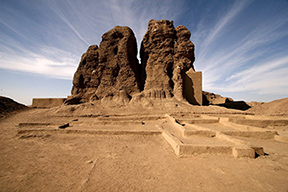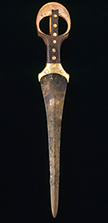HistoryThe Kushite Kingdom at KermaThe Kushite kingdom traces its roots to the city of Kerma. While the start of civilization in Kerma may be traced back to the fourth millennium BC, the kingdom is thought to have sprang in approximately 2600 BC. The wealth of the kingdom is reflected in the archeology, particularly the burial findings of the royalty. Gold, ivory, and various types of jewelry attest to an expanded trade network that connected Kerma to the sub-Sahara in the south, the Red Sea coasts in the east, and the Mediterranean world towards the North.
Kerma is known among archeologists for the unique architecture of its metropolis, which reflects an exceptionally high degree of urban organization. The city had its own expanded harbor quarter facing the Nile, thick fortification walls and bastions, royal residence and cemeteries, religious buildings, storehouses, and bakeries.1 Moreover, the archeology of the city indicates that the political structure of the kingdom was more complex than the monocratic political system of ancient Egypt. Authority and power in Kerma were distributed over an expanded class of elites, which encompassed royal dignitaries, wealthy merchants, and high officials and administrators. The archeology of the cemeteries indicates that it wasn't just the rulers that had splendid burials. Because of this, the political structure at Kerma seems to have anticipated the government system of Kush of the Napatan-Meroeitic period. During the latter period, the political authority of the kingdom was distributed between the priesthood, the king, royal dignitaries, and the military. One problem that faces archeologists and historians in studying Kerma is the lack of surviving written documents. This is due to two possible reasons: (1) Perishable mediums, such as wood and mud, which form common types of building materials in Kerma, did not allow the survival of paint-based writings and/or carved inscriptions; or (2) the destruction activities that took place during the Egyptian invasion of the city in the sixteenth century BC.
Fortunately, some archeological evidence and external written sources provide important indications on the development and expansion of the Kushite kingdom at Kerma. The Old Kingdom inscription of Harkhuf,2 suggests that the Egyptian pharaohs were worried about the ambitions of the Kushite kings in controlling Lower Nubia. Geographically, Lower Nubia has represented a buffer zone separating Egypt and Kush. Although the northern area of Lower Nubia was often Egyptian territory, its local population tended to ally with the Kushites.3 During the First Intermediate Period, when Egypt's power was waning, the Nubian C-Group population in Lower Nubia seems to have enjoyed a considerably high level of freedom. While the economy of Egypt was declining, archeological data from Lower Nubia suggest that the C-Group were politically indipendent.4 Historically, the Kushites have used their power of influence over Lower Nubia to intice rebellions within Egypt. Consequently, Egyptian controlled Lower Nubia exposed Egypt to Kushite colonial ambitions. Hence, the political independence achieved by the Lower Nubians during the First Intermediate Period is attributed to support from Kush. This suggestion corroborates the account of Harkhuf, in which Lower Nubia is indicated as being absorbed by a larger state in Sudan.5The Hyksos invasion of Lower Egypt, around 1786 BC, was a golden opportunity for the Kushites to expand northward. In 1650 BC, Kush made alliance with the Hyksos. While the Hyksos ruled Lower Egypt, the Kushites controlled Upper Egypt. The authority of independent Egyptian kings was consequently limited to a small area around Thebes.6 The population of Upper Egypt, on the other hand, seems to have accepted the domination of Kush without resistance. This is best indicated by lack of any evidence for rebellions in the region. After the Egyptian pharaoh Ahmose defeated the Hyksos in 1550 BC, he turned his attention to Kush. Ahmose had to defeat Kush in order for him to ensure control over Upper Egypt. The war with the Kushites lasted for fifty years, with wins and losses on both sides. Persistent invasions of nomadic groups in the peripheries of Kerma weakened the Kushite kingdom. By 1500 BC, the Kushites were overwhelmed and were defeated by the invading Egyptian armies. Although Kerma was sacked in 1500 BC, the fate of the Kushite kingdom remains the subject of ongoing controversy among scholars today.
|

